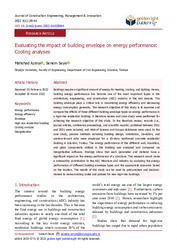Evaluating the impact of building envelope on energy performance: Cooling analyses
| dc.contributor.author | Azima, Mahshad | |
| dc.contributor.author | Seyis, Senem | |
| dc.date.accessioned | 2022-04-18T18:35:47Z | |
| dc.date.available | 2022-04-18T18:35:47Z | |
| dc.date.issued | 2022-03-31 | |
| dc.identifier.issn | 2630-5771 | en_US |
| dc.identifier.uri | http://hdl.handle.net/10679/7678 | |
| dc.identifier.uri | https://www.goldenlightpublish.com/dosyalar/baski/JCEMI_2022_310.pdf | |
| dc.description.abstract | Buildings require a significant amount of energy for heating, cooling, and lighting. Hence, building energy performance has become one of the most important topics in the architecture, engineering, and construction (AEC) industry in the last decade. The building envelope plays a critical role in maximizing energy efficiency and decreasing energy consumption generally. The research objective of this study is to examine and compare the effects of three different building envelope types on energy performance in a high-rise residential building. A literature review and case study were performed for achieving the research objective of this study. In the literature review, records (i.e., journal articles, conference proceedings, and scientific reports) published between 2011 and 2021 were included, and Web of Science and Scopus databases were used. In the case study, passive methods including building design, orientation, insulation, and window-to-wall ratio were employed for a 10-story reinforced concrete residential building in Istanbul, Turkey. The energy performance of the different wall, insulation, and glass components utilized in the building was analyzed and compared via DesignBuilder software. Findings show that each parameter and material have a significant impact on the energy performance of a structure. This research would make a noteworthy contribution to the AEC literature and industry by analyzing the energy performance of different building envelope types and the appropriate scenarios based on the location. The results of this study can be used by policymakers and decisionmakers to revise existing codes and policies for new high-rise buildings. | en_US |
| dc.language.iso | eng | en_US |
| dc.publisher | Golden Light Publishing | en_US |
| dc.relation.ispartof | Journal of Construction Engineering, Management & Innovation | |
| dc.rights | openAccess | |
| dc.title | Evaluating the impact of building envelope on energy performance: Cooling analyses | en_US |
| dc.type | Article | en_US |
| dc.description.version | Publisher version | en_US |
| dc.peerreviewed | yes | en_US |
| dc.publicationstatus | Published | en_US |
| dc.contributor.department | Özyeğin University | |
| dc.contributor.authorID | (ORCID 0000-0002-9133-9899 & YÖK ID 258625) Seyis, Senem | |
| dc.contributor.authorID | (ORCID 0000-0002-9133-9899 & YÖK ID 258625) Seyis, Senem | |
| dc.contributor.ozuauthor | Seyis, Senem | |
| dc.identifier.volume | 5 | en_US |
| dc.identifier.startpage | 28 | en_US |
| dc.identifier.endpage | 44 | en_US |
| dc.subject.keywords | Energy performance | en_US |
| dc.subject.keywords | Energy efficiency | en_US |
| dc.subject.keywords | Envelope | en_US |
| dc.subject.keywords | High-rise residential building | en_US |
| dc.subject.keywords | Cooling analysis | en_US |
| dc.subject.keywords | DesignBuilder | en_US |
| dc.contributor.ozugradstudent | Azima, Mahshad | |
| dc.contributor.authorFemale | 2 | |
| dc.relation.publicationcategory | Article - International Refereed Journal - Institution Academic Staff and Graduate Student |
Files in this item
This item appears in the following Collection(s)
Share this page



